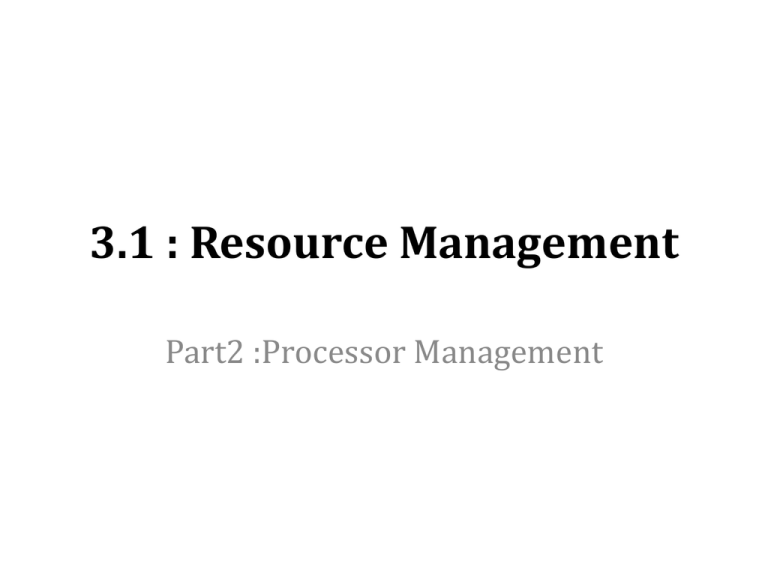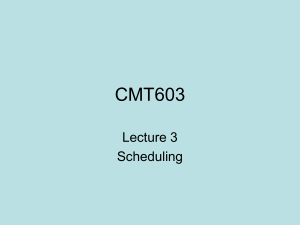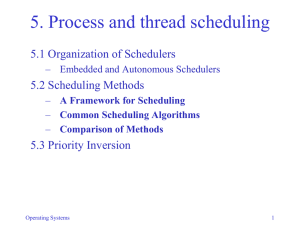3.1 Resource Management
advertisement

3.1 : Resource Management Part2 :Processor Management Learning Outcomes 3.1.1 Understand Processor Management 3.1.2 Various type of scheduling processes 3.1.3 Scheduling Algorithms – First in first out (FIFO) – Shortest Job First (Nonpreemptive SJF) – Shortest Remaining Time (Preemptive SJF) – Round Robin Scheduling – Priority Processor Management • To know how Processor Manager allocates a single CPU to execute the jobs / processes from those user. • Task of Processor Manager : Decide i. How to allocate the CPU ii. Monitor whether it’s executing or waiting a process . iii.Control job entry to ensure balanced use of resources Process • • • • Process is a program in execution When process execute it changes state State represent process’s current activity Each process may be in one of the following state, which are : – New : the process is being created – Running : instruction are being executed – Waiting : the process is waiting for some event to occur (reception of signal) – Ready : the process is waiting to be assigned to a processor – Terminated : the process has finished execution Process • Waiting queue is place for not executing process. • Ready queue is contains all the processes that are ready to execute and waiting for the CPU. • Each process is represent by PCB (Process Control Block) PCB (Process Control Block) • PCB contains many pieces of information with specific process which are; – Process state : new, running, waiting, ready and terminated – Program counter : the counter indicate the address of the next instruction to be executed – CPU Register: include accumulator, index register stack pointer and so on . – CPU Scheduling algorithm : includes a process priority, or others CPU scheduling algorithm – Memory – management information : may include such information as the value of the limit and base register, the page table or segment table, depend on which memory scheme used by operating system. • PCB can linked together to a ready queue Scheduling Concept • The objective of Multiprogramming is to have some process running at all times, - to maximize CPU utilization • Objective of Time-Sharing is to switch the CPU among processes – so frequently that user can interact with each program while it is running. • A uniprocessor/ single – user system can have only one running process. If more processes exist, the rest must wait until the CPU is free and can be rescheduled. Process Scheduling • Therefore process scheduling is need for schedule processes on your system • Why to schedule ? To decide which process to run first if there have more than one process is run able. • Scheduler is part of O/S which make this decision. Schematic of scheduling Preempted request Arriving requests Scheduled request Scheduler Pending requests Figure above is shows movement of requests in the system All requests waiting to be executed are kept in a list of pending requests. Whenever scheduling is to be performed, the scheduler examines the pending request and select one for executing. CPU Completed request Data flow Control Flow This request is handed over to the CPU. A request leaves the CPU when it completes or when it is preempted by the scheduler. In which case, it is put back into the list of pending request In either situation, scheduler performs scheduling to select next request to be executed. Cont.. • Preemptive – Interrupts the processing of a job and transfer the CPU to another job. – Strategy of allowing process that are logically run able to be suspended. – It is widely used in time-sharing environments • Nonpreemtive – Always processes a scheduled request to completion – Since only one request is under processing by the CPU at any time, it is not necessary to maintain the distinction between long, medium and short – term scheduling – Example of scheduling are FCFS and SJF scheduling Type of scheduling processes : Long – term Scheduling – Also known as job scheduling – Is the selection of processes to be allowed to compete for the CPU. – Normally Long – Term Scheduling is heavily influenced resource – allocation consideration, especially memory management. Type of scheduling processes : Short– term Scheduling – Also known as CPU Scheduling – Is the selection of one process from ready queue(all the processes that are ready to execute and waiting for the CPU) Scheduling Creteria 1. CPU utilization (Penggunaan CPU) - keep the CPU as busy as possible 2. Throughput(Daya Pemprosesan) – number of processes that complete their execution per time unit 3. Turnaround time (Masa pusingan)– amount of time to execute a particular process 4. Waiting time( Masa menunggu) – amount of time a process has been waiting in the ready queue 5. Response time(Masa tindakbalas) – amount of time it takes from when a request was submitted until the first response is produced, not output (for time-sharing environment) Optimization Criteria • Max; – CPU utilization – throughput • Min; – turnaround time – waiting time – response time Scheduling Algorithm : First Come First Serve • Is nonpreemptive scheduling algorithm. • Handles job according to their arrival time. The early arrive the, the sooner they’re served. • It’s very simple algorithm to implement because it uses FIFO queue. • This algorithm is fine for most batch system, but it unacceptable for interactive systems because interactive users expect quick response time Example : FCFS Process P1 P2 P3 Burst Time (ms) 24 3 3 The Gantt Chart for the schedule is: P1 0 P2 24 P3 27 30 • Waiting time for P1 = 0ms; P2 = 24ms; P3 = 27ms • Average waiting time: (0 + 24 + 27)/3 = 17ms Exercise 1: FCFS • What will happened if the processes arrive in the order P2 , P3 , P1 i. Draw a gantt chart ii. Calculate average waiting time Scheduling Algorithm : Shortest Job First (SJF) • Handles jobs based on the length of their CPU cycle time/ burst time. • When CPU available , it is assigned to the process that has smallest next CPU burst. • If two processes have the same length next CPU burst, FCFS scheduling is used to break the tie. • The SJF scheduling algorithm is optimal that is gives the minimum average waiting time for a given set of processes. Scheduling Algorithm : Shortest Job First (SJF) • Two schemes: – nonpreemptive – once CPU given to the process it cannot be preempted until completes its CPU burst. – preemptive – if a new process arrives with CPU burst length less than remaining time of current executing process, preempt. This scheme is know as the Shortest-Remaining-Time-First (SRTF). Scheduling Algorithm : Shortest Job First (SJF) Nonpreemptive Process Burst Time Arrival Time P1 6 0 P2 8 0 P3 7 0 P4 3 0 P4 0 P1 1 P3 9 ii) Waiting time; P1= 3; P2=16; P3=9; P4=0 P2 16 24 iii) Average waiting time; = ( 3 + 16 + 9 + 0 )/ 4 = 7 ms Scheduling Algorithm : Shortest Job First (SJF) Nonpreemptive Process Burst Time Arrival Time P1 7 0 P2 4 2 P3 1 4 P4 4 5 P1 0 ii) Waiting Time 1. 2. 3. 4. P1 = 0 P2 = 8 – 2 = 6 P3 = 7 – 4 = 3 P4 = 12 – 5 = 7 P3 7 P2 8 P4 12 16 iii) AWT = (0 + 6 + 3 + 7)/4 4 Exercise SJF Nonepreemptive Open your labwork book, page 11(Activity 2) Scheduling Algorithm : Shortest Job First (SJF) Preemptive / SRTF Rules : Current process preempted if a new process with CPU burst time less than remaining burst time for current executing process. Example 1: SRTF Process Burst Time Arrival Time P1 10 0 P2 2 2 P1 0 P2 2 P1 4 ii) Waiting Time P1 = 0 + (4-2) = 2 P2 = 2-2 = 0 12 ii) AWT P1+P2 = 1ms 2 Exercise 1: SRTF Open your labwork book, page 11(Activity 2) Exercise 2 : SRTF Process Burst Time Arrival Time P1 24 0 P2 3 1 P3 3 2 P4 1 3 i) Draw a gantt chart ii) Calculate are waiting time for each process iii) Calculate average waiting time Scheduling Algorithm: Round Robin Scheduling /RR • Is a preemptive process scheduling algorithm • Each process gets a small unit of CPU time (time quantum/time slice), usually 10-100 milliseconds. • Time quantum = time interval • After this time has elapsed, the process is preempted and added to the end of the ready queue. Scheduling Algorithm: RR Scheduling P1 0 Process Burst Time P1 24 P2 3 P3 3 P2 4 P3 7 P1 10 Time Quantum = 4ms P1 14 ii) Waiting time 1. P1 = (0 + (10-4)) = 6 ms 2. P2 = 4 ms 3. P3 = 7 ms P1 18 P1 22 P1 26 30 iii) Average waiting time = ( 6 + 4 + 7 )/ 3 = 5.66 ms Exercise 1: RR Scheduling Open your labwork book, page 14 (Activity 1) Scheduling Algorithm: Priority Scheduling • A priority number (integer) is associated with each process • The CPU is allocated to the process with the highest priority (smallest integer = highest priority). – Preemptive – nonpreemptive • SJF is a priority scheduling where priority is the predicted next CPU burst time. • Problem Starvation ( low priority processes may never execute) • Solution Aging ( as time progresses increase the priority of the process) Example 1: Priority Scheduling 0 P2 1 Process Burst Time Priority P1 10 3 P2 1 1 P3 2 4 P4 1 5 P5 5 2 P5 ii) Waiting time 1. P1 = 6 ms 2. P2 = 0 ms 3. P3 = 16 ms 4. P4 = 18 ms 5. P5 = 1 ms P1 P3 P4 6 16 18 iii) Average waiting time = ( 6 + 0 + 16 + 18 + 1 )/ 5 = 8.2 ms 19 Exercise 1: Priority Scheduling Open your labwork book, page 15 (Activity 2)







